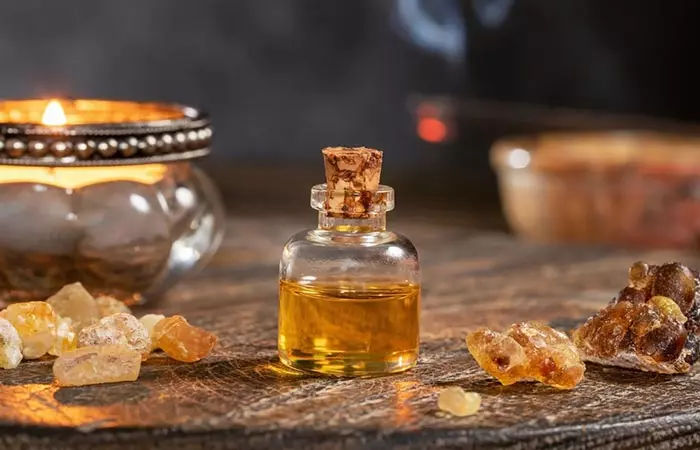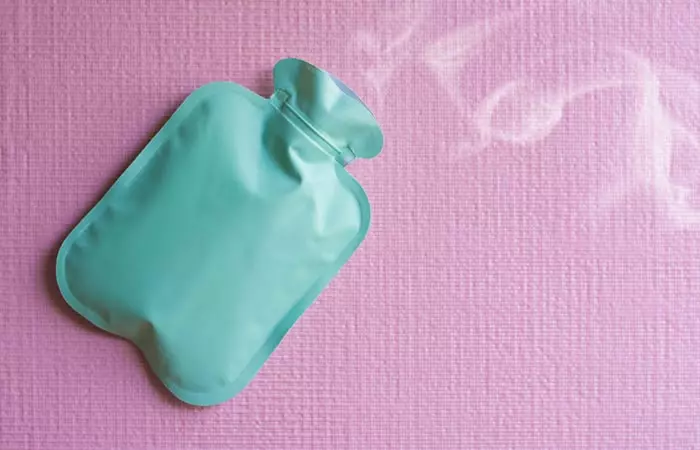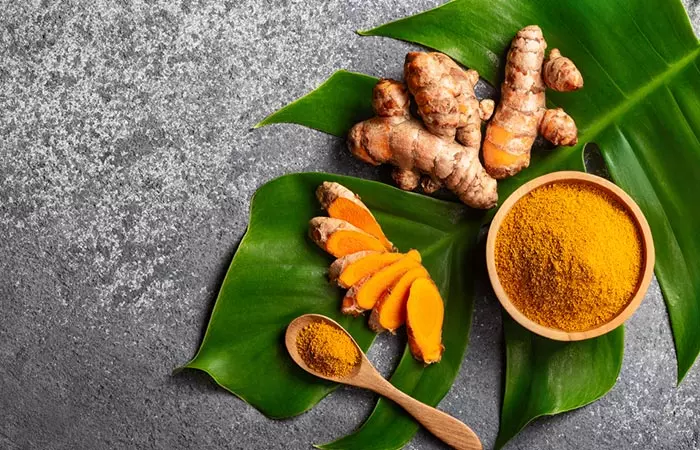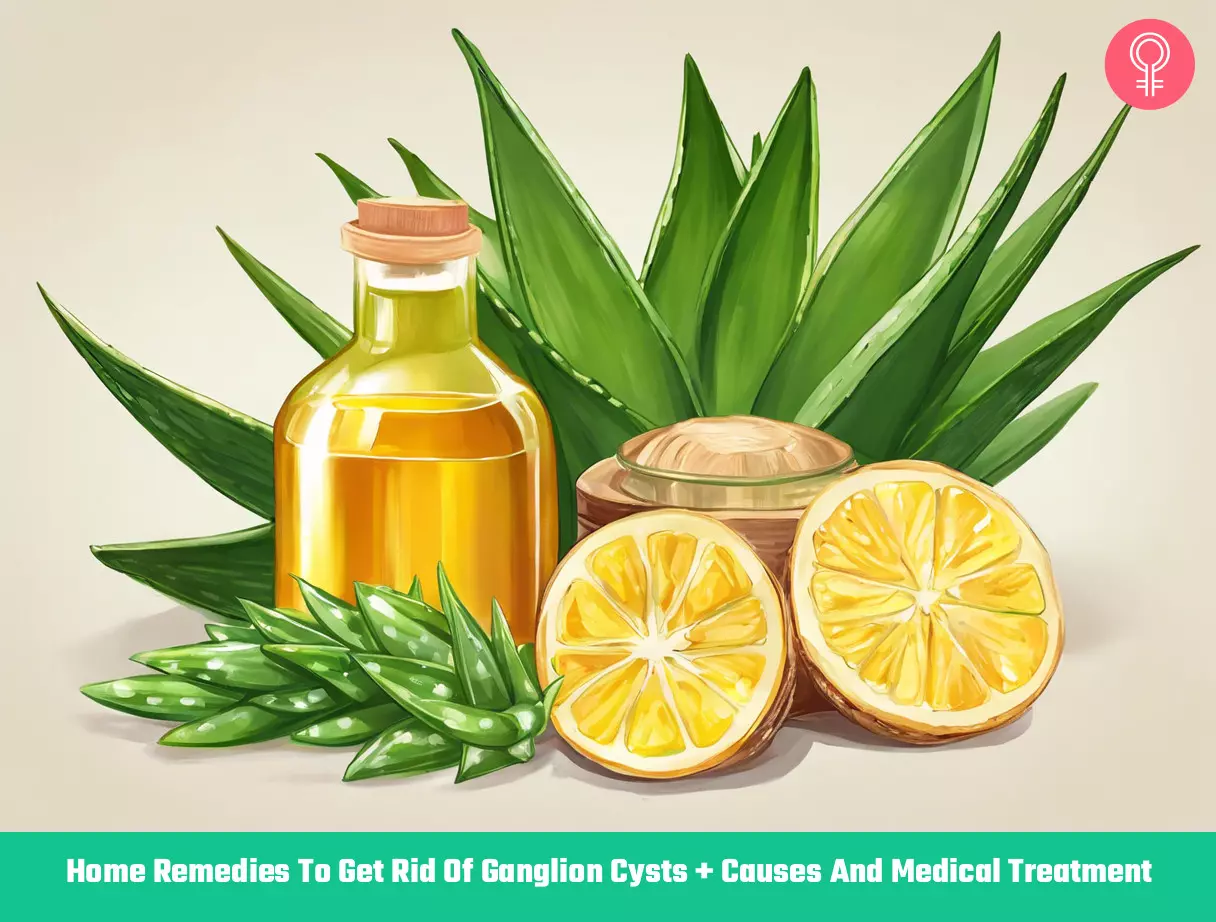Home Remedies To Treat Ganglion Cysts
Note: Most of these ingredients have anti-inflammatory and analgesici A class of pain-relieving drugs that prevent the production of prostaglandins, a chemical substance that stimulates pain sensation. properties that may help in the management of the symptoms of ganglion cysts. However, there is no scientific evidence to prove their efficacy in treating this condition.
1. Essential Oils
a. Frankincense Oil
Frankincense oil possesses anti-inflammatory and analgesic activities (1). These may provide pain relief and speed up the healing of the cyst. You Will Need 2-3 drops of pure frankincense oil What You Have To Do How Often You Should Do This Do this 2 times daily.
b. Lemongrass Oil
Lemongrass oil has pain-relieving and anti-inflammatory properties (2). Hence, it may help in reducing pain and draining out the fluid-filled cyst. You Will Need
3 drops of lemongrass oil 1 teaspoon of coconut oil
What You Have To Do How Often You Should Do This Do this 3-4 times daily.
c. Tea Tree Oil
Tea tree oil possesses anti-inflammatory properties (3). It may help in reducing inflammation and the build-up of fluid within the cyst. You Will Need
2-3 drops of tea tree oil 1 teaspoon of coconut oil Band-aid
What You Have To Do How Often You Should Do This Do this once daily.
2. Apple Cider Vinegar
Apple cider vinegar contains acetic acid, which has anti-inflammatory properties (4). Hence, it may help in reducing inflammation, swelling, and pain associated with ganglion cysts. However, there is no scientific evidence to prove this effect. You Will Need
1 tablespoon of organic apple cider vinegar ¼ cup of water Cotton balls
What You Have To Do How Often You Should Do This Do this 2-3 times daily.
3. Tea Bag
Tea possesses anti-inflammatory and healing properties (5), (6). This can help in healing a ganglion cyst and alleviating the pain associated with it. You Will Need Used black or herbal tea bags What You Have To Do How Often You Should Do This Do this 2-3 times daily.
4. Castor Oil
Castor oil contains ricinoleic acid, which exhibits anti-inflammatory activity (7). Hence, castor oil may be used to treat the inflammation and swelling in the affected area. You Will Need 100% organic castor oil What You Have To Do How Often You Should Do This Do this 1-2 times daily.
5. Warm Compress
A warm compress is an effective therapy that not only relieves inflammation but also soothes the pain associated with ganglion cysts (8). You Will Need A warm compress What You Have To Do How Often You Should Do This Do this once daily for quick relief.
6. Epsom Salt Soak
The immunomodulatoryi The ability of a substance to initiate or inhibit an immune response and aid in the treatment of autoimmune diseases. nature of magnesium in Epsom salt helps in decreasing the production of inflammatory cytokinesi Certain types of proteins secreted by cells that stimulate an inflammatory response in the body. in your body (9). This helps alleviate pain, inflammation, swelling, and redness in the affected area. You Will Need
½ cup of Epsom salt A basin of warm water
What You Have To Do How Often You Should Do This Do this once daily or every alternate day.
7. K Tape
A K tape can offer support and stability to the affected joint, thereby helping in healing the ganglion cyst. It also helps relieve pain and promotes muscle strength (10). You Will Need A K tape What You Have To Do How Often You Should Do This You must keep this tape on the affected joint for 2-4 days.
8. Aloe Vera
Aloe vera has natural healing properties (11). It can also help reduce the swelling and inflammation in the affected area (12). You Will Need Freshly extracted aloe gel What You Have To Do How Often You Should Do This Do this 2-3 times daily.
9. Turmeric
Turmeric contains curcumin, which helps combat inflammation, swelling, and pain (13). This can be used to get rid of ganglion cysts. You Will Need
1 teaspoon of turmeric powder Water (as required)
What You Have To Do How Often You Should Do This Do this 1-2 times daily.
10. Vitamin B-Complex
Vitamin B-complex is a group of water-soluble vitamins that help with cell metabolism (14). It can also help heal ganglion cysts. Foods rich in vitamin B-complex include berries, legumes, lean meat, eggs, tuna, avocado, and spinach. You can consume foods rich in these vitamins or take supplements after consulting your doctor. It is wise to make a few changes to your lifestyle if you have a ganglion cyst. Follow the prevention tips listed below in conjunction with these home remedies to prevent the recurrence of the cysts.
Prevention Tips
Follow a healthy and nutrition-filled diet that consists of fresh fruits, legumes, whole grains, vegetables, and nuts. Drink enough water and keep yourself well hydrated. Give proper rest to the affected joint. Exercise daily. Do not over-stress the affected area.
When To Seek Medical Attention
Although ganglion cysts are mostly benign and disappear on their own, there are occasions when getting medical help is required. Seeking medical advice is crucial if the cyst becomes uncomfortable, particularly when moving, making it difficult for you to carry out your everyday duties. Additionally, apart from ganglion cysts, there could be many reasons for a hard lump under the skin. In such cases, you should consult a doctor immediately, especially if you notice any changes in its size or appearance such as redness, tenderness, etc. If you doubt that you have developed a ganglion cyst, you can visit a doctor to confirm it via a test or diagnosis.
Diagnosis Of Ganglion Cysts
Your doctor may conduct a diagnosis for a ganglion cyst through the following methods:
A holistic physical examination Imaging tests like X-rays, ultrasound, and magnetic resonance imaging. An MRI or ultrasound can also locate hidden cysts.
Besides home remedies, there are alternative medical ways to treat this condition. The following are some medical options that you can opt for to treat ganglion cysts.
What Are The Medical Options To Treat Ganglion Cysts?
Your doctor may initially ask you to wait a bit to check if the ganglion cyst heals on its own. However, if it doesn’t heal or begins to pain and interferes with joint movement, your doctor may suggest:
- Temporary Immobilization: Using a brace or splint to restrict movement and reduce the size of the cyst.
Pros: Non-invasive, relieving, and may potentially decrease the cyst naturally. Cons: May result in stiffness and weakening in the muscles. The cyst may reappear if movement is not restricted properly.
- Aspiration: Draining the fluid from the cyst with a needle.
Pros: Quick, non-invasive, rapid relief, minimal recovery time. Cons: Cysts frequently recur, not effective for solid/thick-walled cysts
- Surgery: Complete removal of the cyst and its stalk. Surgery may be required only if other approaches haven’t worked.
Pros: Reduces the chance of recurrence and is a more permanent solution. Cons: Longer healing time, lower probability of recurrence, infection, scarring, and nerve injury.
According to Dr. Marc Matarazzo, MD, a board-certified orthopedic surgeon, “Massage, immobilization, mechanical rupture, needle aspiration, acupuncture, Chinese Fire needle, and surgical excision are the treatments that give the best chance of permanent cure.”
Signs And Symptoms Of Ganglion Cysts
Discomfort and pain in the affected area Loss of mobility Numbness A tingling sensation
Some ganglion cysts may also become bigger or smaller with time. Are you wondering what causes this unpredictable condition? Let’s find out.
Causes And Risk Factors For Ganglion Cysts
As we have already discussed, ganglion cysts usually occur when there is fluid accumulation in the joint or around the tendons in your hands, wrists, ankles, or feet. This accumulation of fluid may be due to an injury, trauma, or even overuse of the body part. Research conducted in 2020 on 2420 patients who underwent wrist arthroscopy in 2015-16 showed that these patients were 8 times more likely to develop a ganglion cyst than the general population. 1.24% (30) participants developed ipsilateral wrist ganglion within 4 months after the procedure. Some factors can also increase your risk of developing ganglion cysts. They are:
Sex and age – Ganglion cysts are more common in women aged between 20 and 40. Medical conditions like osteoarthritisi A type of arthritis that affects cartilage tissues capsuling the ends of bones, resulting in deformity and degeneration of joints. Injured tendons or joints
Now that you know the causes behind ganglion cysts, scroll down to the next section to learn about the different types of ganglion cysts.
Types Of Ganglion Cyst
The two primary types of ganglion cysts are:
Dorsal Wrist Ganglion Cysts: These are the most common type and appear on the back of the wrist. They often occur in the joint or tendon in the wrist. They may or may not be visible and often vary in size (15). Volar (Palmar) Wrist Ganglion Cysts: These are less common and occur on the base of the finger on the palm side of the wrist. They arise from the tendon sheath of the finger. They can cause discomfort and affect hand function (16).
Note that ganglion cysts may sometimes resolve on their own but may require medical attention if they cause pain or extreme discomfort. Can you massage a ganglion cyst away? Check out the infographic below for a shortlist of the most simple and easily accessible home remedies for ganglion cysts.Illustration: StyleCraze Design Team Dr. Matarazzo says, “Ganglion cysts are fluid-filled sacs, so massaging may rupture them, which will at least temporarily reduce the size of the cysts. They tend to fluctuate in size, so while the massage may not directly eliminate them, they may appear to improve over time.” How long does it take for a ganglion cyst to go away? Most of the time, a ganglion cyst may disappear in a couple of weeks, only to reappear months or even years later. But this may not be the case with all, and some may achieve complete recovery from these cysts in due course of time. Can a ganglion cyst turn out to be cancerous? Unlike tumors and other forms of cysts, ganglion cysts are non-cancerous. You may sometimes notice them growing in size, but that is completely natural. What is the difference between a ganglion cyst and a synovial cyst? A ganglion cyst is just a fluid-filled sac that may develop in the joints of your ankles or wrists. On the other hand, a synovial cyst has a thin layer of tissue surrounding it. This tissue layer is absent in a ganglion cyst. What happens if a ganglion cyst is left untreated? Leaving a ganglion cyst untreated will hardly cause any problems unless it pains or interrupts your joint movement. However, if you are suffering from other forms of cysts, it is wise to avail treatment and medicines immediately as there is a risk of them turning cancerous in the long run. Is heat or ice better for a ganglion cyst? Both methods are useful and can be used as per your preference. Applying an ice pack to your ganglion cyst will help decrease the swelling. A warm compress will relieve your pain, improve blood circulation, and help drain the fluid. Can massage cure a ganglion cyst? While massaging your cyst will not heal it completely, it may help drain the liquid from the sac. This will reduce its size a little and offer some relief. However, proper medical intervention can help remove the cysts completely. Can you pop a ganglion cyst by pushing on it? No, avoid pushing or pressing the ganglion cyst. It can otherwise increase your risk of developing further infection and damage the bones and tissues in the affected area. Do ganglion cysts grow roots? Yes, in many cases, ganglion cysts can grow a stalk-like structure (root) that can be removed via medical procedures. However, it can grow back if not properly removed. Do ganglion cysts hurt when pressed? No, ganglion cysts do not hurt when you press them. However, if they press on a nearby nerve, they can cause pain and disrupt joint movement.
Illustration: Home Remedies To Get Rid Of Ganglion Cysts + Causes And Medical Treatment
Seeking effective home remedies for treating ganglion cysts? Watch this video to discover five easy and natural solutions to reduce the pain and swelling caused by this condition.













